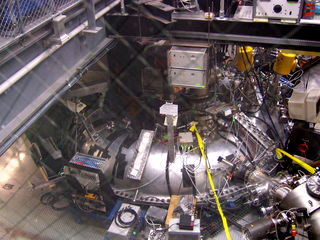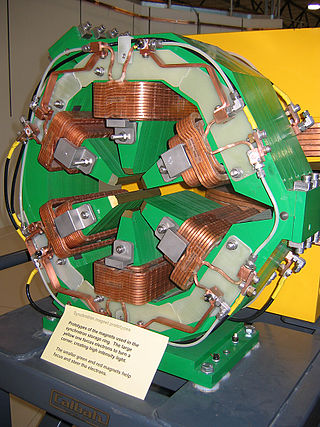
A lens is a transmissive optical device that focuses or disperses a light beam by means of refraction. A simple lens consists of a single piece of transparent material, while a compound lens consists of several simple lenses (elements), usually arranged along a common axis. Lenses are made from materials such as glass or plastic and are ground, polished, or molded to the required shape. A lens can focus light to form an image, unlike a prism, which refracts light without focusing. Devices that similarly focus or disperse waves and radiation other than visible light are also called "lenses", such as microwave lenses, electron lenses, acoustic lenses, or explosive lenses.

Transmission electron microscopy (TEM) is a microscopy technique in which a beam of electrons is transmitted through a specimen to form an image. The specimen is most often an ultrathin section less than 100 nm thick or a suspension on a grid. An image is formed from the interaction of the electrons with the sample as the beam is transmitted through the specimen. The image is then magnified and focused onto an imaging device, such as a fluorescent screen, a layer of photographic film, or a detector such as a scintillator attached to a charge-coupled device or a direct electron detector.

A linear particle accelerator is a type of particle accelerator that accelerates charged subatomic particles or ions to a high speed by subjecting them to a series of oscillating electric potentials along a linear beamline. The principles for such machines were proposed by Gustav Ising in 1924, while the first machine that worked was constructed by Rolf Widerøe in 1928 at the RWTH Aachen University. Linacs have many applications: they generate X-rays and high energy electrons for medicinal purposes in radiation therapy, serve as particle injectors for higher-energy accelerators, and are used directly to achieve the highest kinetic energy for light particles for particle physics.

Time of flight (ToF) is the measurement of the time taken by an object, particle or wave to travel a distance through a medium. This information can then be used to measure velocity or path length, or as a way to learn about the particle or medium's properties. The traveling object may be detected directly or indirectly. Time of flight technology has found valuable applications in the monitoring and characterization of material and biomaterials, hydrogels included.
Accelerator physics is a branch of applied physics, concerned with designing, building and operating particle accelerators. As such, it can be described as the study of motion, manipulation and observation of relativistic charged particle beams and their interaction with accelerator structures by electromagnetic fields.

Quadrupole magnets, abbreviated as Q-magnets, consist of groups of four magnets laid out so that in the planar multipole expansion of the field, the dipole terms cancel and where the lowest significant terms in the field equations are quadrupole. Quadrupole magnets are useful as they create a magnetic field whose magnitude grows rapidly with the radial distance from its longitudinal axis. This is used in particle beam focusing.

In electromagnetism, electrostatic deflection refers to a way of modifying the path of a beam of charged particles by the use of an electric field applied transverse to the path of the particles. The technique is called electrostatic because the strength and direction of the applied field changes slowly relative to the time it takes for the particles to transit the field, and thus can be considered not to change for any single particle.

Electron-beam welding (EBW) is a fusion welding process in which a beam of high-velocity electrons is applied to two materials to be joined. The workpieces melt and flow together as the kinetic energy of the electrons is transformed into heat upon impact. EBW is often performed under vacuum conditions to prevent dissipation of the electron beam.

A teltron tube (named for Teltron Inc., which is now owned by 3B Scientific Ltd.) is a type of cathode ray tube used to demonstrate the properties of electrons. There were several different types made by Teltron including a diode, a triode, a Maltese Cross tube, a simple deflection tube with a fluorescent screen, and one which could be used to measure the charge-to-mass ratio of an electron. The latter two contained an electron gun with deflecting plates. The beams can be bent by applying voltages to various electrodes in the tube or by holding a magnet close by. The electron beams are visible as fine bluish lines. This is accomplished by filling the tube with low pressure helium (He) or Hydrogen (H2) gas. A few of the electrons in the beam collide with the helium atoms, causing them to fluoresce and emit light.

The Madison Symmetric Torus (MST) is a reversed field pinch (RFP) physics experiment with applications to both fusion energy research and astrophysical plasmas.

Electron optics is a mathematical framework for the calculation of electron trajectories in the presence of electromagnetic fields. The term optics is used because magnetic and electrostatic lenses act upon a charged particle beam similarly to optical lenses upon a light beam.
An electron spectrometer is a device used to perform different forms of electron spectroscopy and electron microscopy. This requires analyzing the energy of an incoming beam of electrons. Most electron spectrometers use a hemispherical electron energy analyzer in which the beam of electrons is bent with electric or magnetic fields. Higher energy electrons will be bent less by the beam, this produces a spatially distributed range of energies.
An einzel lens, or unipotential lens, is a charged particle electrostatic lens that focuses without changing the energy of the beam. It consists of three or more sets of cylindrical or rectangular apertures or tubes in series along an axis. It is used in ion optics to focus ions in flight, which is accomplished through manipulation of the electric field in the path of the ions.

In accelerator physics strong focusing or alternating-gradient focusing is the principle that, using sets of multiple electromagnets, it is possible to make a particle beam simultaneously converge in both directions perpendicular to the direction of travel. By contrast, weak focusing is the principle that nearby circles, described by charged particles moving in a uniform magnetic field, only intersect once per revolution.

A particle accelerator is a machine that uses electromagnetic fields to propel charged particles to very high speeds and energies to contain them in well-defined beams. Small accelerators are used for fundamental research in particle physics. Accelerators are also used as synchrotron light sources for the study of condensed matter physics. Smaller particle accelerators are used in a wide variety of applications, including particle therapy for oncological purposes, radioisotope production for medical diagnostics, ion implanters for the manufacture of semiconductors, and accelerator mass spectrometers for measurements of rare isotopes such as radiocarbon.

A magnetic lens is a device for the focusing or deflection of moving charged particles, such as electrons or ions, by use of the magnetic Lorentz force. Its strength can often be varied by usage of electromagnets.

A sextupole magnet consist of six magnetic poles set out in an arrangement of alternating north and south poles arranged around an axis. They are used in particle accelerators for the control of chromatic aberrations and for damping the head—tail transverse plasma instability. Two sets of sextupole magnets are used in transmission electron microscopes to correct for spherical aberration.

Explorer 54, also known as AE-D, was a NASA scientific satellite belonging to the Atmosphere Explorer series launched on 6 October 1975 from Vandenberg Air Force Base aboard a Thor-Delta 2910 launch vehicle.
Direct energy conversion (DEC) or simply direct conversion converts a charged particle's kinetic energy into a voltage. It is a scheme for power extraction from nuclear fusion.
A stigmator is a component of electron microscopes that reduces astigmatism of the beam by imposing a weak electric or magnetic quadrupole field on the electron beam.














